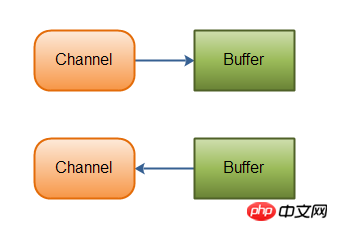
Java NIO consists of the following core parts:
Channels
Buffers
Selectors
Although there are many classes and components in Java NIO, in my opinion, Channel, Buffer and Selector constitute The core API. Other components, such as Pipe and FileLock, are just utility classes used with the three core components. Therefore, in this overview I will focus on these three components. Other components are covered in separate chapters.
Basically, all IO starts from a Channel in NIO. Channels are a bit like streams. Data can be read from the Channel to the Buffer, or written from the Buffer to the Channel. Here is an illustration:

#There are several types of Channel and Buffer. The following are the implementations of some major Channels in JAVA NIO:
FileChannel
DatagramChannel
SocketChannel
ServerSocketChannel
As you can see, these channels cover UDP and TCP network IO, as well as file IO.
Along with these classes there are some interesting interfaces, but for the sake of simplicity I tried not to mention them in the overview. I will explain them in other chapters of this tutorial where they are relevant.
The following is the key Buffer implementation in Java NIO:
ByteBuffer
CharBuffer
DoubleBuffer
FloatBuffer
IntBuffer
LongBuffer
ShortBuffer
These Buffers cover the basic data types you can send through IO: byte, short, int, long, float, double and char.
Java NIO also has a MappedByteBuffer, which is used to represent memory mapped files. I am not going to explain it in the overview.
Selector allows a single thread to process multiple Channels. If your application opens multiple connections (channels), but the traffic of each connection is very low, using Selector can be convenient. For example, in a chat server.
This is an illustration of using a Selector to process 3 Channels in a single thread:

To use the Selector, you must register with the Selector Channel, and then calls its select() method. This method will block until a registered channel has an event ready. Once this method returns, the thread can handle these events. Examples of events include new connections coming in, data receiving, etc.
Related articles:
Java NIO series tutorial 2: Java NIO channel-like stream
Java NIO Series Tutorial 3: Basic Usage of Buffer
Related Videos:
Illustration of JDK Download Process-JAVA Elementary Introduction Video Tutorial
The above is the detailed content of Java NIO series tutorial 1: A brief introduction to Java NIO. For more information, please follow other related articles on the PHP Chinese website!




